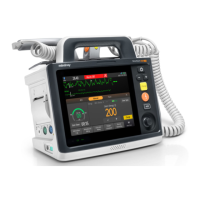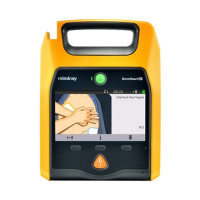6 - 2
• Successful resuscitation is dependent on many variables specific to the patient’s physiological state
and the circumstances surrounding the patient event. Failure to have a successful patient outcome is
not a reliable indicator of equipment performance. The presence or absence of a muscular response
to the transfer of energy during electrical therapy is not a reliable indicator of energy delivery or
equipment performance.
6.2 External Defibrillation Procedure
6.2.1 Using the Electrode Pads for External Defibrillation
• Anterior - lateral placement for adult patients, and anterior-posterior placement for pediatric
patients are recommended placements for defibrillation with electrode pads.
• For defibrillation of pediatric patients, you can use the default energy level, or adjust the energy
level to 2-4 J/kg for the first shock and 4 J/kg for additional shocks followed the first shock.
• For defibrillation of pediatric patients under 8 years, pediatric electrode pads should be used.
• If pediatric electrode pads are not available, the adult electrode pads may be used instead, and set
Patient Category to Ped.
• For defibrillation of neonatal patients, set the energy level according to the patient’s clinical
condition. The energy level for neonatal patient should be lower than the default setting.
6.2.2 Using the External Paddles for External Defibrillation
• Hold only the insulating parts of the paddle handles to avoid shock hazard during charging or shock
delivery.
• Anterior - lateral placement is the only placement for defibrillation with external paddles.
• When external paddles are used, the Shock button on the front panel is disabled.
• For defibrillation of pediatric patients, you can use the default energy level, or adjust the energy
level to 2-4 J/kg for the first shock and 4 J/kg for additional shocks followed the first shock.
• For defibrillation of neonatal patients, set the energy level according to the patient’s clinical
condition. The energy level for neonatal patient should be lower than the default setting.
6.3 Internal Defibrillation Procedure
• To avoid possible cardiac damage from higher energies, the energy selection for internal
defibrillation is limited to 50J.
• Clean and sterilize the internal paddles after each use. Otherwise, severe infection may result.
6.4 Synchronized Cardioversion
• Using internal paddles for synchronized cardioversion requires that the patient’s ECG be acquired
through a standard ECG cable. The patient’s ECG acquired through the internal paddles may be
unreliable for synchronized cardioversion due to excessive noise or artifact causing inappropriate R-
wave detection.

